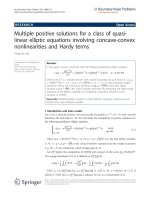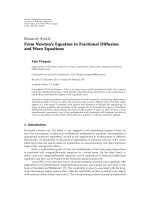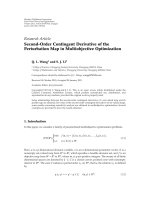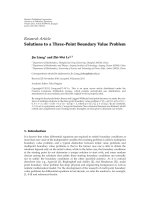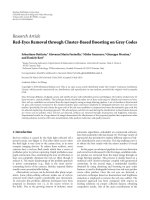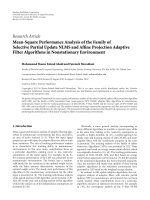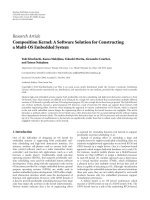Báo cáo hóa học: " Research Article Schur-Convexity for a Class of Symmetric Functions and Its Applications" pptx
Bạn đang xem bản rút gọn của tài liệu. Xem và tải ngay bản đầy đủ của tài liệu tại đây (527.41 KB, 15 trang )
Hindawi Publishing Corporation
Journal of Inequalities and Applications
Volume 2009, Article ID 493759, 15 pages
doi:10.1155/2009/493759
Research Article
Schur-Convexity for a Class of Symmetric
Functions and Its Applications
Wei-Feng Xia
1
and Yu-Ming Chu
2
1
School of Teacher Education, Huzhou Teachers College, Huzhou 313000, China
2
Department of Mathematics, Huzhou Teachers College, Huzhou 313000, China
Correspondence should be addressed to Yu-Ming Chu,
Received 16 May 2009; Accepted 14 September 2009
Recommended by Jozef Banas
For x x
1
,x
2
, ,x
n
∈ R
n
, the symmetric function φ
n
x, r is defined by φ
n
x, rφ
n
x
1
,
x
2
, ,x
n
; r
1≤i
1
<i
2
···<i
r
≤n
r
j1
x
i
j
/1x
i
j
1/r
,wherer 1, 2, ,nand i
1
,i
2
, ,i
n
are positive
integers. In this article, the Schur convexity, Schur multiplicative convexity and Schur harmonic
convexity of φ
n
x, r are discussed. As applications, some inequalities are established by use of the
theory of majorization.
Copyright q 2009 W F. Xia and Y M. Chu. This is an open access article distributed under the
Creative Commons Attribution License, which permits unrestricted use, distribution, and
reproduction in any medium, provided the original work is properly cited.
1. Introduction
Throughout this paper we use R
n
to denote the n-dimensional Euclidean space over the field
of real numbers and R
n
{x
1
,x
2
, ,x
n
: x
i
> 0,i 1, 2, ,n}. In particular, we use R to
denote R
1
.
For the sake of convenience, we use the following notation system.
For x x
1
,x
2
, ,x
n
,yy
1
,y
2
, ,y
n
∈ R
n
,andα>0, let
x y
x
1
y
1
,x
2
y
2
, ,x
n
y
n
,
xy
x
1
y
1
,x
2
y
2
, ,x
n
y
n
,
αx
αx
1
,αx
2
, ,αx
n
,
x
α
x
α
1
,x
α
2
, ,x
α
n
,
1
x
1
x
1
,
1
x
2
, ,
1
x
n
,
2 Journal of Inequalities and Applications
log x
log x
1
, log x
2
, ,log x
n
,
e
x
e
x
1
,e
x
2
, ,e
x
n
.
1.1
The notion of Schur convexity was first introduced by Schur in 1923 1.Ithas
many important applications in analytic inequalities 2–7, combinatorial optimization 8,
isoperimetric problem for polytopes 9, linear regression 10, graphs and matrices 11 ,
gamma and digamma functions 12, reliability and availability 13, and other related fields.
The following definition for Schur convex or concave can be found in 1, 3, 7 and the
references therein.
Definition 1.1. Let E ⊆ R
n
n ≥ 2 be a set, a real-valued function F on E is called a Schur
convex function if
F
x
1
,x
1
, ,x
n
≤ F
y
1
,y
2
, ,y
n
1.2
for each pair of n-tuples x x
1
, ,x
n
and y y
1
, ,y
n
on E, such that x is majorized
by y in symbols x ≺ y,thatis,
k
i1
x
i
≤
k
i1
y
i
,k 1, 2, ,n− 1,
n
i1
x
i
n
i1
y
i
,
1.3
where x
i
denotes the ith largest component in x. F is called Schur concave if −F is Schur
convex.
The notation of multiplicative convexity was first introduced by Montel 14.The
Schur multiplicative convexity was investigated by Niculescu 15, Guan 7,andChuet
al. 16.
Definition 1.2 see 7, 16.LetE ⊆ R
n
n ≥ 2 be a set, a real-valued function F : E → R
is
called a Schur multiplicatively convex function on E if
F
x
1
,x
2
, ,x
n
≤ F
y
1
,y
2
, ,y
n
1.4
for each pair of n-tuples x x
1
,x
2
, ,x
n
and y y
1
,y
2
, ,y
n
on E, such that x is
logarithmically majorized by y in symbols log x ≺ log y,thatis,
k
i1
x
i
≤
k
i1
y
i
,k 1, 2, ,n− 1,
n
i1
x
i
n
i1
y
i
.
1.5
However F is called Schur multiplicatively concave if 1/F is Schur multiplicatively convex.
Journal of Inequalities and Applications 3
In paper 17, Anderson et al. discussed an attractive class of inequalities, which
arise from the notion of harmonic convex functions. Here, we introduce the notion of Schur
harmonic convexity.
Definition 1.3. Let E ⊆ R
n
n ≥ 2 be a set. A real-valued function F on E is called a Schur
harmonic convex function if
F
x
1
,x
2
, ,x
n
≤ F
y
1
,y
2
, ,y
n
1.6
for each pair of n-tuples x x
1
,x
2
, ,x
n
and y y
1
,y
2
, ,y
n
on E, such that 1/x ≺ 1/y.
F is called a Schur harmonic concave function on E if 1.6 is reversed.
The main purpose of this paper is to discuss the Schur convexity, Schur multiplicative
convexity, and Schur harmonic convexity of the following symmetric function:
φ
n
x, r
φ
n
x
1
,x
2
, ,x
n
; r
1≤i
1
<i
2
···<i
r
≤n
⎛
⎝
r
j1
x
i
j
1 x
i
j
⎞
⎠
1/r
,
1.7
where x x
1
,x
2
, ,x
n
∈ R
n
n ≥ 2, r 1, 2, ,n,andi
1
,i
2
, ,i
r
are positive integers. As
applications, some inequalities are established by use of the theory of majorization.
2. Lemmas
In order to establish our main results we need several lemmas, which we present in this
section.
The following lemma is so-called Schur’s condition which is very useful for
determining whether or not a given function is Schur convex or Schur concave.
Lemma 2.1 see 6, 7, 18. Let f : R
n
0, ∞
n
→ R
0, ∞ be a continuous symmetric
function. If f is differentiable in R
n
,thenf is Schur convex if and only if
x
i
− x
j
∂f
∂x
i
−
∂f
∂x
j
≥ 0 2.1
for all i, j 1, 2, ,n and x x
1
, ,x
n
∈ R
n
.Alsof is Schur concave if and only if 2.1 is
reversed for all i, j 1, 2, ,n and x x
1
, ,x
n
∈ R
n
. Here, f is a symmetric function in R
n
meaning that fPxfx for any x ∈ R
n
and any n × n permutation matrix P.
Remark 2.2. Since f is symmetric, the Schur’s condition in Lemma 2.1,thatis,2.1 can be
reduced to
x
1
− x
2
∂f
∂x
1
−
∂f
∂x
2
≥ 0.
2.2
4 Journal of Inequalities and Applications
Lemma 2.3 see 7, 16. Let f : R
n
→ R
be a continuous symmtric function. If f is differentiable
in R
n
,thenf is Schur multiplicatively convex if and only if
log x
1
− log x
2
x
1
∂f
∂x
1
− x
2
∂f
∂x
2
≥ 0
2.3
for all x x
1
,x
2
, ,x
n
∈ R
n
.Alsof is Schur multiplicatively concave if and only if 2.3 is
reversed.
Lemma 2.4. Let f : R
n
→ R
be a continuous symmetric function. If f is differentiable in R
n
,then
f is Schur harmonic convex if and only if
x
1
− x
2
x
2
1
∂f
∂x
1
− x
2
2
∂f
∂x
2
≥ 0
2.4
for all x x
1
,x
2
, ,x
n
∈ R
n
.Alsof is Schur harmonic concave if and only if 2.4 is reversed.
Proof. From Definitions 1.1 and 1.3, we clearly see the fact that f : R
n
→ R
is Schur harmonic
convex if and only if Fx1/f1/x : R
n
→ R
is Schur concave.
This fact, Lemma 2.1 and Remark 2.2 together with elementary calculation imply that
Lemma 2.4 is true.
Lemma 2.5 see 5, 6. Let x x
1
,x
2
, ,x
n
∈ R
n
and
n
i1
x
i
s.Ifc ≥ s,then
c − x
nc/s − 1
c − x
1
nc/s − 1
,
c − x
2
nc/s − 1
, ,
c − x
n
nc/s − 1
≺
x
1
,x
2
, ,x
n
x. 2.5
Lemma 2.6 see 6. Let x x
1
,x
2
, ,x
n
∈ R
n
and
n
i1
x
i
s.Ifc ≥ 0,then
c x
nc/s 1
c x
1
nc/s 1
,
c x
2
nc/s 1
, ,
c x
n
nc/s 1
≺
x
1
,x
2
, ,x
n
x. 2.6
Lemma 2.7 see 19. Suppose that x x
1
,x
2
, ,x
n
∈ R
n
and
n
i1
x
i
s. If 0 ≤ λ ≤ 1, then
s − λx
n − λ
s − λx
1
n − λ
,
s − λx
2
n − λ
, ,
s − λx
n
n − λ
≺
x
1
,x
2
, ,x
n
x.
2.7
3. Main Results
Theorem 3.1. For r ∈{1, 2, ,n}, the symmetric function φ
n
x, r is Schur concave in R
n
.
Proof. By Lemma 2.1 and Remark 2.2, we only need to prove that
x
1
− x
2
∂φ
n
x, r
∂x
1
−
∂φ
n
x, r
∂x
2
≤ 0
3.1
for all x x
1
,x
2
, ,x
n
∈ R
n
and r 1, 2, ,n.
Journal of Inequalities and Applications 5
The proof is divided into four cases.
Case 1. If r 1, then 1.7 leads to
φ
n
x, 1
φ
n
x
1
,x
2
, ,x
n
;1
n
i1
x
i
1 x
i
.
3.2
However 3.2 and elementary computation lead to
x
1
− x
2
∂φ
n
x, 1
∂x
1
−
∂φ
n
x, 1
∂x
2
−
x
1
− x
2
2
1 x
1
x
2
x
1
x
2
1 x
1
1 x
2
φ
n
x, 1
≤ 0.
3.3
Case 2. If n ≥ 2andr n, then 1.7 yields
φ
n
x, n
φ
n
x
1
,x
2
, ,x
n
; n
n
i1
x
i
1 x
i
1/n
.
3.4
From 3.4 and elementary computation, we have
x
1
− x
2
∂φ
n
x, n
∂x
1
−
∂φ
n
x, n
∂x
2
−
x
1
− x
2
2
2 x
1
x
2
n
1 x
1
2
1 x
2
2
n
i1
x
i
1 x
i
1/n−1
≤ 0.
3.5
Case 3. If n ≥ 3andr 2, then by 1.7 we have
φ
n
x, 2
φ
n
x
1
,x
2
, ···,x
n
;2
x
1
1 x
1
x
2
1 x
2
1/2
⎡
⎣
n
j3
x
1
1 x
1
x
j
1 x
j
1/2
⎤
⎦
φ
n−1
x
2
,x
3
, ,x
n
;2
x
2
1 x
2
x
1
1 x
1
1/2
⎡
⎣
n
j3
x
2
1 x
2
x
j
1 x
j
1/2
⎤
⎦
φ
n−1
x
1
,x
3
, ,x
n
;2
.
3.6
6 Journal of Inequalities and Applications
Elementary computation and 3.6 yield
x
1
− x
2
∂φ
n
x, 2
∂x
1
−
∂φ
n
x, 2
∂x
2
−
x
1
− x
2
2
1 x
1
1 x
2
φ
n
x, 2
2
×
⎡
⎣
2 x
1
x
2
x
1
x
2
2x
1
x
2
n
j3
1 x
1
x
2
3 2x
1
2x
2
x
j
1 x
j
x
1
x
j
2x
1
x
j
x
2
x
j
2x
2
x
j
⎤
⎦
≤ 0.
3.7
Case 4. If n ≥ 4and3≤ r ≤ n − 1, then from 1.7, we have
φ
n
x, r
φ
n
x
1
,x
2
, ,x
n
; r
φ
n−1
x
2
,x
3
, ,x
n
; r
3≤i
1
<i
2
<···<i
r−1
≤n
⎛
⎝
x
1
1 x
1
r−1
j1
x
i
j
1 x
i
j
⎞
⎠
1/r
×
3≤i
1
<i
2
<···<i
r−2
≤n
⎛
⎝
x
1
1 x
1
x
2
1 x
2
r−2
j1
x
i
j
1 x
i
j
⎞
⎠
1/r
φ
n−1
x
1
,x
3
, ,x
n
; r
3≤i
1
<i
2
<···<i
r−1
≤n
⎛
⎝
x
2
1 x
2
r−1
j1
x
i
j
1 x
i
j
⎞
⎠
1/r
×
3≤i
1
<i
2
<···<i
r−2
≤n
⎛
⎝
x
1
1 x
1
x
2
1 x
2
r−2
j1
x
i
j
1 x
i
j
⎞
⎠
1/r
,
3.8
x
1
− x
2
∂φ
n
x, r
∂x
1
−
∂φ
n
x, r
∂x
2
−
x
1
− x
2
2
1 x
1
2
1 x
2
2
×
⎡
⎢
⎣
3≤i
1
<i
2
<···<i
r−2
≤n
2x
1
x
2
x
1
/
1x
1
x
2
/
1x
2
r−2
j1
x
i
j
/
1x
i
j
3≤i
1
<i
2
<···<i
r−1
≤n
1x
1
x
2
2x
1
x
2
r−1
j1
x
i
j
/1x
i
j
x
1
/
1x
1
r−1
j1
x
i
j
/
1x
i
j
x
2
/
1x
2
r−1
j1
x
i
j
/
1 x
i
j
⎤
⎥
⎦
×
φ
n
x, r
r
≤ 0.
3.9
Therefore, 3.1 follows from Cases 1–4 and the proof of Theorem 3.1 is completed.
Journal of Inequalities and Applications 7
For the Schur multiplicative convexity or concavity of φ
n
x, r,wehavethefollowing
theorem
Theorem 3.2. It holds that φ
n
x, r is Schur multiplicatively concave in 1, ∞
n
.
Proof. According to Lemma 2.3 we only need to prove that
log x
1
− log x
2
x
1
∂φ
n
x, r
∂x
1
− x
2
∂φ
n
x, r
∂x
2
≤ 0
3.10
for all x x
1
,x
2
, ,n ∈ 1, ∞
n
and r 1, 2, ,n.Then proof is divided into four cases.
Case 1. If r 1, then 3.2 leads to
log x
1
− log x
2
x
1
∂φ
n
x, 1
∂x
1
− x
2
∂φ
n
x, 1
∂x
2
−
log x
1
− log x
2
x
1
− x
2
1 x
1
1 x
2
φ
n
x, 1
≤ 0.
3.11
Case 2. If r n, n ≥ 2, then 3.4 yields
log x
1
− log x
2
x
1
∂φ
n
x, n
∂x
1
− x
2
∂φ
n
x, n
∂x
2
log x
1
− log x
2
x
1
− x
2
n
1 x
1
2
1 x
2
2
1 − x
1
x
2
n
i1
x
i
1 x
i
1/n−1
≤ 0.
3.12
Case 3. If n ≥ 3andr 2, then 3.6 implies
log x
1
− log x
2
x
1
∂φ
n
x, 2
∂x
1
− x
2
∂φ
n
x, 2
∂x
2
φ
n
x, 2
2
log x
1
− log x
2
x
1
− x
2
1 x
1
2
1 x
2
2
×
⎡
⎣
1 − x
1
x
2
x
1
/
1 x
1
x
2
/
1 x
2
n
j3
−x
1
x
2
1 − x
1
x
2
x
j
/
1 x
j
x
1
/
1 x
1
x
j
/
1 x
j
x
2
/
1 x
2
x
j
/
1 x
j
⎤
⎦
≤ 0.
3.13
8 Journal of Inequalities and Applications
Case 4. If n ≥ 4and3≤ r ≤ n − 1, then from 3.8 we have
log x
1
− log x
2
x
1
∂φ
n
x, r
∂x
1
− x
2
∂φ
n
x, r
∂x
2
log x
1
− log x
2
x
1
− x
2
1 x
1
2
1 x
2
2
×
⎡
⎢
⎣
3≤i
1
<i
2
<···<i
r−2
≤n
1 − x
1
x
2
x
1
/
1 x
1
x
2
/
1 x
2
r−2
j1
x
i
j
/
1 x
i
j
3≤i
1
<i
2
<···<i
r−1
≤n
−x
1
x
2
1 − x
1
x
2
r−1
j1
x
i
j
/
1 x
i
j
x
1
/
1x
1
r−1
j1
x
i
j
/
1 x
i
j
x
2
/
1x
2
r−1
j1
x
i
j
/
1 x
i
j
⎤
⎥
⎦
×
φ
n
x, r
r
≤ 0.
3.14
Therefore, Theorem 3.2 follows from 3.10 and Cases 1–4.
Remark 3.3. From 3.11 and 3.12 we know that φ
n
x, 1 is Schur multiplicatively concave
in 0, ∞
n
and φ
n
x, n is Schur multiplicatively convex in 0, 1
n
.
Theorem 3.4. For r ∈{1, 2, ,n}, the symmetric function φ
n
x, r is Schur harmonic convex in
R
n
.
Proof. According to Lemma 2.4 we only need to prove that
x
1
− x
2
x
2
1
∂φ
n
x, r
∂x
1
− x
2
2
∂φ
n
x, r
∂x
2
≥ 0
3.15
for all x x
1
,x
2
, ,x
n
∈ R
n
and r 1, 2, ,n.
The proof is divided into four cases.
Case 1. If r 1, then from 3.2 we have
x
1
− x
2
x
2
1
∂φ
n
x, 1
∂x
1
− x
2
2
∂φ
n
x, 1
∂x
2
x
1
− x
2
2
1 x
1
1 x
2
φ
n
x, 1
≥ 0.
3.16
Case 2. If n ≥ 2andr n, then 3.4 leads to
x
1
− x
2
x
2
1
∂φ
n
x, n
∂x
1
− x
2
2
∂φ
n
x, n
∂x
2
x
1
− x
2
2
x
1
x
2
2x
1
x
2
n
1 x
1
2
1 x
2
2
n
i1
x
i
1 x
i
1/n−1
≥ 0.
3.17
Journal of Inequalities and Applications 9
Case 3. If n ≥ 3andr 2, then 3.6 yields
x
1
− x
2
x
2
1
∂φ
n
x, 2
∂x
1
− x
2
2
∂φ
n
x, 2
∂x
2
x
1
− x
2
2
1 x
1
1 x
2
φ
n
x, 2
2
×
⎡
⎣
1
n
j3
x
1
x
2
x
1
x
j
x
2
x
j
3x
1
x
2
x
j
1 x
j
x
1
x
j
2x
1
x
j
x
2
x
j
2x
2
x
j
⎤
⎦
≥ 0.
3.18
Case 4. If n ≥ 4and3≤ r ≤ n − 1, then 3.8 implies
x
1
− x
2
x
2
1
∂φ
n
x, r
∂x
1
− x
2
2
∂φ
n
x, r
∂x
2
x
1
− x
2
2
1 x
1
2
1 x
2
2
φ
n
x, r
r
×
⎡
⎢
⎣
3≤i
1
<i
2
<···<i
r−2
≤n
x
1
x
2
2x
1
x
2
x
1
/
1 x
1
x
2
/
1 x
2
r−2
j1
x
i
j
/
1 x
i
j
3≤i
1
<i
2
<···<i
r−1
≤n
x
1
x
2
x
1
x
2
2x
1
x
2
r−2
j1
x
i
j
/
1x
i
j
x
1
/
1x
1
r−1
j1
x
i
j
/
1 x
i
j
x
2
/
1 x
2
r−1
j1
x
i
j
/
1 x
i
j
⎤
⎥
⎦
≥ 0.
3.19
Therefore, 3.15 follows from Cases 1–4 and the proof of Theorem 3.4 is completed.
4. Applications
In this section, we establish some inequalities by use of Theorems 3.1, 3.2 and 3.4 and the
theory of majorization.
Theorem 4.1. If x x
1
,x
2
, ···,x
n
∈ R
n
, s
n
i1
x
i
,H
n
xn/
n
i1
1/x
i
, and r ∈
{1, 2, ,n},then
1 φ
n
x, r ≤ φ
n
c − x/nc/s − 1,r for c ≥ s;
2 φ
n
x, r ≥ φ
n
cH
n
x − 1/cx − 1x, r for c ≥
n
i1
1/x
i
;
3 φ
n
x, r ≤ φ
n
c x/nc/s 1,r for c ≥ 0;
4 φ
n
x, r ≥ φ
n
cH
n
x1/cx 1x, r for c ≥ 0;
5 φ
n
x, r ≤ φ
n
s − λx/n − λ,r for 0 ≤ λ ≤ 1;
10 Journal of Inequalities and Applications
6 φ
n
x, r ≥ φ
n
n − λ/
n
i1
1/x
i
− λ/x ,r for 0 ≤ λ ≤ 1;
7 φ
n
x, r ≤ φ
n
s λx/n λ,r for 0 ≤ λ ≤ 1;
8 φ
n
x, r ≥ φ
n
n λ/
n
i1
1/x
i
λ/x ,r for 0 ≤ λ ≤ 1.
Proof. Theorem 4.1 follows from Theorem 3.1, Theorem 3.4 and Lemmas 2.5–2.7 together with
the fact that
s λx
n λ
s λx
1
n λ
,
s λx
2
n λ
, ,
s λx
n
n λ
≺
x
1
,x
2
, ,x
n
x.
4.1
Theorem 4.2. If x x
1
,x
2
, ···,x
n
∈ R
n
, A
n
x1/n
n
i1
x
i
, and r ∈{1, 2, ,n},then
i
1≤i
1
<i
2
<···<i
r
≤n
⎛
⎝
r
j1
x
i
j
1 x
i
j
⎞
⎠
1/r
≤
r
A
n
x
A
n
1 x
n!/r·r!n−r!
;
ii
1≤i
1
<i
2
<···<i
r
≤n
⎛
⎝
r
j1
1
1 x
i
j
⎞
⎠
1/r
≥
r
1
A
n
1 x
n!/r·r!n−r!
.
4.2
Proof. We clearly see that
A
n
x
,A
n
x
, ,A
n
x
≺
x
1
,x
2
, ,x
n
x. 4.3
Therefore, Theorem 4.2i follows from 4.3 and Theorem 3.1 together with 1.7,and
Theorem 4.2ii follows from 4.3 and Theorem 3.4 together with 1.7.
If we take r 1inTheorem 4.2i and r n in Theorem 4.2, respectively, then we have
the following corollary.
Corollary 4.3. If x x
1
,x
2
, ,x
n
∈ R
n
and G
n
x
n
i1
x
i
1/n
,then
i
G
n
x
G
n
1 x
≤
A
n
x
A
n
1 x
;
ii
A
n
x
1 x
≤
A
n
x
A
n
1 x
;
iii
A
n
1
1 x
≥
1
A
n
1 x
.
4.4
Remark 4.4. If we take
n
i1
x
i
1inCorollary 4.3i, then we obtain the Weierstrass
inequality: see 20, page 260
n
i1
1
x
i
1
≥
n 1
n
.
4.5
Journal of Inequalities and Applications 11
Theorem 4.5. If x x
1
,x
2
, ,x
n
∈ R
n
and r ∈{1, 2, ,n},then
i
1≤i
1
<i
2
<···<i
r
≤n
⎛
⎝
r
j1
x
i
j
1 x
i
j
⎞
⎠
1/r
≥
r
H
n
x
1 H
n
x
n!/r·r!n−r!
;
ii
1≤i
1
<i
2
<···<i
r
≤n
⎛
⎝
r
j1
1
1 x
i
j
⎞
⎠
1/r
≤
r
1
1 H
n
x
n!/r·r!n−r!
.
4.6
Proof. We clearly see that
1
H
n
x
,
1
H
n
x
, ,
1
H
n
x
≺
1
x
1
,
1
x
2
, ,
1
x
n
1
x
.
4.7
Therefore, Theorem 4.5i follows from 4.7 and Theorem 3.4 together with 1.7,and
Theorem 4.5ii follows from 4.7 and Theorem 3.1 together with 1.7.
If we take r 1andr n in Theorem 4.5, respectively, then we get the following
corollary.
Corollary 4.6. If x x
1
,x
2
, ,x
n
∈ R
n
,then
i
G
n
x
G
n
1 x
≥
H
n
x
1 H
n
x
;
ii
G
n
1 x
≥ 1 H
n
x
;
iii
A
n
x
1 x
≥
H
n
x
1 H
n
x
;
iv
A
n
1
1 x
≤
1
1 H
n
x
.
4.8
Theorem 4.7. If x x
1
,x
2
, ,x
n
∈ 1, ∞
n
and r ∈{1, 2, ,n},then
1≤i
1
<i
2
<···<i
r
≤n
⎛
⎝
r
j1
x
i
j
1 x
i
j
⎞
⎠
1/r
≤
r
G
n
x
1 G
n
x
n!/r·r!n−r!
.
4.9
Proof. We clearly see that
log
G
n
x
,G
n
x
, ,G
n
x
≺ log
x
1
,x
2
, ,x
n
. 4.10
Therefore, Theorem 4.7 follows from 4.10, Theorem 3.2,and1.7.
12 Journal of Inequalities and Applications
If we take r 1andr n in Theorem 4.7, respectively, then we get the following
corollary.
Corollary 4.8. If x x
1
,x
2
, ,x
n
∈ 1, ∞
n
,then
i
A
n
x
1 x
≤
G
n
x
1 G
n
x
;
ii
G
n
1 x
≥ 1 G
n
x
.
4.11
Remark 4.9. From Remark 3.3 and 4.10 together with 1.7 we clearly see that inequality in
Corollary 4.8i is reversed for x ∈ 0, 1
n
and inequality in Corollary 4.8ii is true for x ∈ R
n
.
Theorem 4.10. If x x
1
,x
2
, ···,x
n
∈ R
n
, then
i
1≤i
1
<i
2
···<i
r
≤n
⎛
⎝
r
j1
1 x
i
j
2 x
i
j
⎞
⎠
1/r
≥
1
n
i1
x
i
2
n
i1
x
i
r − 1
2
n−1
!/r!
n−r
!
×
r
2
n−1
!/r·r!
n−r−1
!
for 1 ≤ r ≤ n − 1;
ii
n
i1
1 x
i
2 x
i
≥
1
n
i1
x
i
2
n
i1
x
i
n − 1
2
;
iii
1≤i
1
<i
2
···<i
r
≤n
⎛
⎝
r
j1
1
2 x
i
j
⎞
⎠
1/r
≤
1
2
n
i1
x
i
r − 1
2
n−1
!/
r−1
!
n−r
!
×
r
2
n−1
!/r·r!
n−r−1
!
for 1 ≤ r ≤ n − 1;
iv
n
i1
1
2 x
i
≤
1
2
n
i1
x
i
n − 1
2
.
4.12
Proof. Theorem 4.10 follows from Theorems 3.1, 3.4,and1.7 together with the fact that
1 x
1
, 1 x
2
, ,1 x
n
≺
1
n
i1
x
i
, 1, 1, ,1
.
4.13
Theorem 4.11. Let A A
1
A
2
···A
n1
be an n-dimensional simplex in R
n
and let P be an arbitrary
point in the interior of A.IfB
i
is the intersection point of straight line A
i
P and hyperplane
i
A
1
A
2
···A
i−1
A
i1
···A
n1
,i 1, 2, ,n 1, t hen for r ∈{1, 2, ,n 1} one has
i
1≤i
1
<i
2
···<i
r
≤n1
⎛
⎝
r
j1
PB
i
j
A
i
j
B
i
j
PB
i
j
⎞
⎠
1/r
≤
r
n 2
n1!/r·r!n−r1!
;
Journal of Inequalities and Applications 13
ii
1≤i
1
<i
2
···<i
r
≤n1
⎛
⎝
r
j1
A
i
j
B
i
j
A
i
j
B
i
j
PB
i
j
⎞
⎠
1/r
≥
r
n 1
n 2
n1!/r·r!n−r1!
;
iii
1≤i
1
<i
2
···<i
r
≤n1
⎛
⎝
r
j1
PA
i
j
A
i
j
B
i
j
PA
i
j
⎞
⎠
1/r
≤
r
n
2n 1
n1!/r·r!n−r1!
;
iv
1≤i
1
<i
2
···<i
r
≤n1
⎛
⎝
r
j1
A
i
j
B
i
j
A
i
j
B
i
j
PA
i
j
⎞
⎠
1/r
≥
r
n 1
2n 1
n1!/r·r!n−r1!
.
4.14
Proof. It is easy to see that
n1
i1
PB
i
/A
i
B
i
1and
n1
i1
PA
i
/A
i
B
i
n, these identical
equations imply
1
n 1
,
1
n 1
, ,
1
n 1
≺
PB
1
A
1
B
1
,
PB
2
A
2
B
2
, ,
PB
n1
A
n1
B
n1
,
n
n 1
,
n
n 1
, ,
n
n 1
≺
PA
1
A
1
B
1
,
PA
2
A
2
B
2
, ,
PA
n1
A
n1
B
n1
.
4.15
Therefore, Theorem 4.11 follows from 4.15, Theorems 3.1, 3.4,and1.7.
Remark 4.12. Mitrinovic’ et al. 21, pages 473–479 established a series of inequalities for
PA
i
/A
i
B
i
and PB
i
/A
i
B
i
, i 1, 2, ,n 1. Obvious, our inequalities in Theorem 4.11 are
different from theirs.
Theorem 4.13. Suppose that A ∈ M
n
Cn ≥ 2 is a complex matrix, λ
1
,λ
2
, ,λ
n
, and
σ
1
,σ
2
, ,σ
n
are the eigenvalues and singular values of A, respectively. If A is a positive definite
Hermitian matrix and r ∈{1, 2, ,n}, then
i
1≤i
1
<i
2
···<i
r
≤n
⎛
⎝
r
j1
λ
i
j
1 λ
i
j
⎞
⎠
1/r
≤
r
trA
n trA
n!/r·r!n−r!
;
ii
1≤i
1
<i
2
···<i
r
≤n
⎛
⎝
r
j1
1
1 λ
i
j
⎞
⎠
1/r
≥
r
n
n trA
n!/r·r!n−r!
;
iii
1≤i
1
<i
2
···<i
r
≤n
⎛
⎝
r
j1
1 λ
i
j
2 λ
i
j
⎞
⎠
1/r
≤
r
n
detI A
1
n
detI A
n!/r·r!n−r!
;
iv
1≤i
1
<i
2
···<i
r
≤n
⎛
⎝
r
j1
1
trA λ
i
j
⎞
⎠
1/r
≤
r
1
trA
n
√
detA
n!/r·r!n−r!
;
14 Journal of Inequalities and Applications
v
1≤i
1
<i
2
···<i
r
≤n
⎛
⎝
r
j1
1
λ
i
j
n
i1
λ
i
n
i1
σ
i
⎞
⎠
1/r
≥
1≤i
1
<i
2
···<i
r
≥n
⎛
⎝
r
j1
1
σ
i
j
n
i1
λ
i
n
i1
σ
i
⎞
⎠
1/r
.
4.16
Proof. i–ii We clearly see that λ
i
> 0 i 1, 2, ,n and
n
i1
λ
i
trA, then we have
trA
n
,
trA
n
, ,
trA
n
≺
λ
1
,λ
2
, ,λ
n
. 4.17
Therefore, Theorem 4.13i and ii follows from 4.17, Theorems 3.1, 3.4,and1.7.
iii It is easy to see that 1 λ
1
, 1 λ
2
, ,1 λ
n
are the eigenvalues of matrix I A and
n
i1
1 λ
i
detI A, then we get
log
n
det
I A
,
n
det
I A
, ,
n
det
I A
≺ log
1 λ
1
, 1 λ
2
, ,1 λ
n
1 λ
i
≥ 1,i 1, 2, ,n.
4.18
Therefore, Theorem 4.13iii follows from 4.18, Theorem 3.2,and1.7.
iv It is not difficult to verify that
log
trA
n
√
det A
,
trA
n
√
det A
, ,
trA
n
√
det A
≺ log
trA
λ
1
,
trA
λ
2
, ,
trA
λ
n
,
trA
λ
i
≥ 1,i 1, 2, ,n.
4.19
Therefore, Theorem 4.13iv follows from 4.19,andTheorem 3.2 together with 1.7.
v A result due to Weyl 22 gives
log
λ
1
,λ
2
, ,λ
n
≺ log
σ
1
,σ
2
, ,σ
n
. 4.20
From 4.20, we clearly see that
log
n
i1
λ
i
n
i1
σ
i
λ
1
,
n
i1
λ
i
n
i1
σ
i
λ
2
, ,
n
i1
λ
i
n
i1
σ
i
λ
n
≺ log
n
i1
λ
i
n
i1
σ
i
σ
1
,
n
i1
λ
i
n
i1
σ
i
σ
2
, ,
n
i1
λ
i
n
i1
σ
i
σ
n
n
i1
λ
i
n
i1
σ
i
λ
i
,
n
i1
λ
i
n
i1
σ
i
σ
i
≥ 1,i 1, 2, ,n.
, 4.21
Therefore, Theorem 4.13v follows from 4.21, Theorem 3.2,and1.7.
Journal of Inequalities and Applications 15
Acknowledgment
This work was supported by the National Science Foundation of China no. 60850005 and
the Natural Science Foundation of Zhejiang Province no. D7080080, Y607128, Y7080185.
References
1 I. Schur, “
¨
Uber eine klasse von mittelbildungen mit anwendungen auf die determinantentheorie,”
Sitzungsberichte der Berliner Mathematischen Gesellschaft, vol. 22, pp. 9–20, 1923.
2 G. H. Hardy, J. E. Littlewood, and G. P
´
olya, “Some simple inequalities satisfied by convex functions,”
Messenger of Mathematics, vol. 58, pp. 145–152, 1929.
3 C. Stepolhkepniak, “An effective characterization of Schur-convex functions with applications,”
Journal of Convex Analysis, vol. 14, no. 1, pp. 103–108, 2007.
4 J. S. Aujla and F. C. Silva, “Weak majorization inequalities and convex functions,” Linear Algebra and
Its Applications, vol. 369, pp. 217–233, 2003.
5 K. Guan, “The Hamy symmetric function and its generalization,” Mathematical Inequalities &
Applications, vol. 9, no. 4, pp. 797–805, 2006.
6 K Z. Guan, “Schur-convexity of the complete symmetric function,” Mathematical Inequalities &
Applications, vol. 9, no. 4, pp. 567–576, 2006.
7 K Z. Guan, “Some properties of a class of symmetric functions,” Journal of Mathematical Analysis and
Applications, vol. 336, no. 1, pp. 70–80, 2007.
8 F. K. Hwang and U. G. Rothblum, “Partition-optimization with Schur convex sum objective
functions,” SIAM Journal on Discrete Mathematics, vol. 18, no. 3, pp. 512–524, 2004.
9 X M. Zhang, “Schur-convex functions and isoperimetric inequalities,” Proceedings of the American
Mathematical Society, vol. 126, no. 2, pp. 461–470, 1998.
10 C. Stepolhkepniak, “Stochastic ordering and Schur-convex functions in comparison of linear
experiments,” Metrika, vol. 36, no. 5, pp. 291–298, 1989.
11 G. M. Constantine, “Schur convex functions on the spectra of graphs,” Discrete Mathematics, vol. 45,
no. 2-3, pp. 181–188, 1983.
12 M. Merkle, “Convexity, Schur-convexity and bounds for the gamma function involving the digamma
function,” The Rocky Mountain Journal of Mathematics, vol. 28, no. 3, pp. 1053–1066, 1998.
13 F. K. Hwang, U. G. Rothblum, and L. Shepp, “Monotone optimal multipartitions using Schur
convexity with respect to partial orders,” SIAM Journal on Discrete Mathematics, vol. 6, no. 4, pp. 533–
547, 1993.
14 P. Montel, “Sur les fonctions convexes et les fonctions sousharmoniques,” Journal de Math
´
ematiques,
vol. 7, no. 9, pp. 29–60, 1928.
15 C. P. Niculescu, “Convexity according to the geometric mean,” Mathematical Inequalities & Applications,
vol. 3, no. 2, pp. 155–167, 2000.
16 Y. Chu, X. Zhang, and G. Wang, “The Schur geometrical convexity of the extended mean values,”
Journal of Convex Analysis, vol. 15, no. 4, pp. 707–718, 2008.
17 G. D. Anderson, M. K. Vamanamurthy, and M. Vuorinen, “Generalized convexity and inequalities,”
Journal of Mathematical Analysis and Applications, vol. 335, no. 2, pp. 1294–1308, 2007.
18 A. W. Marshall and I. Olkin, Inequalities: Theory of Majorization and Its Applications, vol. 143 of
Mathematics in Science and Engineering, Academic Press, New York, NY, USA, 1979.
19 S H. Wu, “Generalization and sharpness of the power means inequality and their applications,”
Journal of Mathematical Analysis and Applications, vol. 312, no. 2, pp. 637–652, 2005.
20 P. S. Bullen, A Dictionary of Inequalities, vol. 97, Longman, Harlow, UK, 1998.
21 D. S. Mitrinovi
´
c, J. E. Pe
ˇ
cari
´
c, and V. Volenec, Recent Advances in Geometric Inequalities, vol. 28, Kluwer
Academic Publishers, Dordrecht, The Netherlands, 1989.
22 H. Weyl, “Inequalities between the two kinds of eigenvalues of a linear transformation,” Proceedings
of the National Academy of Sciences of the United States of America, vol. 35, pp. 408–411, 1949.
